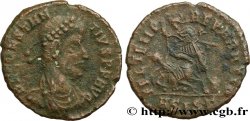v16_0126 - REGNO DI PARTIA - ARTABAN IV Drachme
MONNAIES 16 (2002)
起拍价 : 2 000.00 €
估价 : 4 000.00 €
未售出的物品
起拍价 : 2 000.00 €
估价 : 4 000.00 €
未售出的物品
种类 Drachme
日期: n.d.
铸币厂名称/城市 Ecbatane
材质 silver
直径 17 mm
模子方针 12 h.
重量 3,67 g.
稀少度 UNIQUE
关于品相的说明
Exemplaire de qualité exceptionnelle pour une monnaie extraordinaire, de la plus grande rareté. Magnifique patine de médaillier. Petit flan, mais parfaitement centré des deux côtés
出版目录中的项代码 :
家谱
Cet exemplaire provient de la collection Delorme
正面
正面的文字 ANÉPIGRAPHE.
正面的说明书 Buste d’Artaban IV à gauche, tête coiffée de la tiare avec oreillette, un bandeau simple, avec nœud qui tombe derrière la tête, la barbe triangulaire longue bifide et pointue ; la tiare est gemmée ou perlée et richement décorée ; derrière la tiare, abréviation d’Artaban.
背面
背面的文字 LÉGENDE CORROMPUE, GRECQUE ET PEHLVI.
背面的说明书 Archer assis à gauche sur un trône, tenant un arc de la main droite ; au-dessous, un monogramme.
评论
Semble complètement inédit et non répertorié. Manque à tous les ouvrages consultés. De la plus grande rareté. Cet exemplaire est illustré dans l’article de P. Delorme (N&C 321, p. 39, fig. 40). P. Delorme lui a aussi consacré un article complet (fiche technique) dans (N&C. 330, p. 81-82).
Appears to be completely unpublished and unlisted. Missing from all consulted works. Extremely rare. This example is illustrated in P. Delorme's article (N&C 321, p. 39, fig. 40). P. Delorme also devoted a complete article (technical sheet) to it in (N&C. 330, p. 81-82)
Appears to be completely unpublished and unlisted. Missing from all consulted works. Extremely rare. This example is illustrated in P. Delorme's article (N&C 321, p. 39, fig. 40). P. Delorme also devoted a complete article (technical sheet) to it in (N&C. 330, p. 81-82)








 对产品描述纠错
对产品描述纠错 打印
打印 分享我的选择
分享我的选择 提问
提问 Consign / sell
Consign / sell










